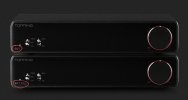Yes, the Flex Eight makes sense. The 2x4 or Flex Balanced not so much. The DDRC not at all.
The DDRC-22 is not suitable for bi-amping.
The DDRC-24 is a 2x4 HD bundled with Dirac and a mic. Great choice for someone bi-amping and not comfortable using REW and RePhase. As you say, not for tri-amping.
The DDRC-88 is suitable for tri-amping and is functionally similar to a Flex Eight with Dirac and all digital outs. Kind of. Would need 3x stereo DACs, so quickly becomes unattractive.
With the 88BM option, the 88 becomes similar to a digital-only Flex HTx. Kind of.
I wouldn't choose the 88 over the Eight, the HT, or the HTx.
The Flex HT is certainly released. The HTx is pre-launch.
Interesting. Thanks. Arrival day must be getting closer!
The HT shows as available direct from MiniDSP.com on my phone, but on my PC it still shows as pre-order.
Neither the HT nor HTx are listed at the US distributor (Deer Creek Audio).
Anyway, back on topic, if arrival day is closer, I need to finalize my buying choices for more PA7, more Fosi V3, and/or some PA5.
The short version is whether to get 5x more Fosi v3 (the 48v is currently $87 direct), or a mix of V3, PA7, and PA5.
This is ASR, and there's a measurable difference between these amps. It is less clear whether that measurable difference is audible to me in my environment.
When I use a PA7 for tweeters, there is zero hiss, even with my ear pressed on the drivers.
When I use a V3 for tweeters, I can hear hiss 3-4" / 7-10cm away. Not a real world difference.
I think I cannot discriminate between them in AxB back-to-back listening tests at my usual ~8' / ~2.5m from the speakers.
BUT...
When the V3 is on the tweeters, my hearing becomes fatigued after an hour or so.
When the PA7 is on the tweeters, my hearing does not become fatigued.
I have time this weekend to make distortion measurements with REW with each amp on each driver, and based on those data to experiment with crossover settings, then based on those experiments to order amps.
